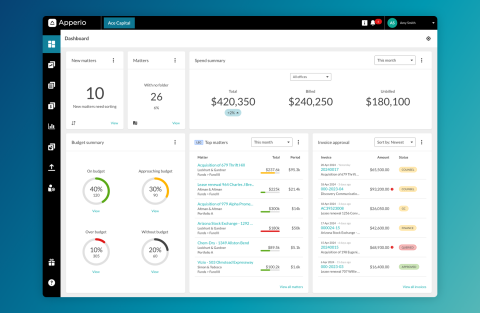2025 legal spend management predictions: Big themes and trends

Right now, legal and finance teams are feeling the squeeze. You're being asked to do more with less, justify every penny spent, and somehow maintain those crucial law firm relationships while keeping costs in check. This balancing act has become increasingly difficult as organizations navigate economic pressures and expanding legal requirements. Sound familiar?
But significant changes are on the horizon. Artificial intelligence has moved beyond basic automation to deliver meaningful predictive insights about legal spend. Solutions like Apperio's BillClear are solving traditional e-billing inefficiencies with a more sophisticated approach. And perhaps most importantly, organizations are shifting from reactive cost management to continuous monitoring and data-driven decision-making.
Think legal spend management is stuck in the past? Think again. 2025 will be the year firms finally gain control of their legal spend. This blog covers the key trends shaping legal spend management in 2025, offering practical insights for legal and finance teams looking to enhance control and visibility over their legal costs.
Legal spend management prediction #1: AI gets real
Remember when AI was just about automating invoice checks? Those days are over. In 2025, AI is doing the heavy lifting that legal and finance teams have wanted for years – spotting budget overruns before they happen, identifying scope creep in real-time, and making smarter decisions about legal spend.
AI now provides insights that prevent problems rather than just spot them. Picture getting an alert that a matter is trending toward a budget overrun based on historical patterns, or identifying which billing arrangements actually deliver the best value. That's the difference between basic automation and true intelligence.
And this is pushing law firms to rethink traditional billing models too. When AI can complete document reviews and compliance checks faster and more accurately than humans, the old hourly rate model starts to look dated. That's why we're seeing more firms offer alternative fee arrangements (AFAs) that focus on value and outcomes rather than time spent.
But here's where AI really shines: AI is giving legal teams back their time. Instead of spending hours reviewing invoices or chasing budget overruns, teams can focus on strategic decisions that actually impact the bottom line. It's about working smarter, not harder.
📕Further reading: Legal tech guide to 2025: 5 innovations to watch
Legal spend management prediction #2: No more surprises with continuous monitoring
If you're still waiting for invoices to arrive before understanding your legal spend, 2025 is your wake-up call. The old way of managing legal costs – scrambling to resolve billing issues and discovering budget overruns months too late – is becoming a thing of the past.
Want proof? Just look at e-billing. It was supposed to simplify everything, but for many organizations, it's created more headaches than solutions. Based on our research, around 30-40% of invoices need queries, turning legal teams into professional invoice reviewers instead of strategic advisors.
Continuous monitoring changes all of this. Instead of discovering budget issues after the fact, you can spot and fix problems the moment they appear. Let’s look at an example: you have a matter budgeted at $200,000. Rather than getting that stomach-dropping moment in December when you realize costs have hit $250,000, you get an alert when spending reaches $180,000. That's the power of continuous monitoring – no surprises, just control.
And it doesn’t end with budget overruns. Continuous monitoring gives you visibility into work in progress (WIP), accruals, spending trends, and potential risks before they become problems. With continuous WIP visibility and spend tracking, teams can work together to resolve issues faster and maintain tighter control over budgets.
📕Further reading: Overcoming the legal spend 'black box' issue
Legal spend management prediction #3: Efficiency becomes non-negotiable
If you're still stuck in endless cycles of invoice reviews and billing queries, 2025 will be good to you. Traditional e-billing was supposed to make life easier, but let's be honest – it often creates more work. The constant back-and-forth over billing discrepancies and compliance checks has turned what should be a simple process into an administrative overhead.
And many organizations find themselves drowning in compliance issues and manual reviews. Legal teams are spending more time chasing queries than focusing on strategic work – that's not just inefficient, it's unsustainable.
Here's the good news: modern tools are finally solving these long-standing problems. Imagine invoices arriving clean, compliant, and ready for approval – no more endless rounds of review and revision. By catching issues before invoices even hit your desk, these systems eliminate the administrative headaches that plague traditional e-billing.
When you remove friction from the billing process, something interesting happens. Law firm relationships improve because there's less back-and-forth over invoices. Your team can focus on strategic priorities instead of administrative tasks.
📕Further reading: Closing the gaps in legal spend management before Year-End: Lessons for 2025
Legal spend management prediction #4: Law firm relationships get a reset
The days of choosing law firms based purely on cost are over. In 2025, smart organizations are looking at the bigger picture: how well firms deliver on their promises, how efficiently they manage matters, and how closely they align with business goals.
Think about your current law firm relationships. Sure, you track their fees and monitor budget overruns. But do you know if they're staffing matters efficiently? Are senior partners being used where their expertise adds real value? Are junior associates handling appropriate tasks? Without the right data, these questions are impossible to answer.
This is where transparency changes everything. When both sides can see WIP, budget status, and billing at any given time, conversations become more productive. Instead of awkward discussions about unexpected invoices, you can have forward-looking talks about matter strategy and resource allocation.
Benchmarking adds another layer of insight. By comparing performance across firms, you can spot patterns that matter. Maybe one firm consistently exceeds budgets while another excels at fixed-fee work. Or perhaps certain types of matters always cost more than expected. These insights help you make smarter decisions about which firms to use for different types of work.
Law firm relationships in 2025 will thrive on shared data and mutual accountability. The most successful organizations won't just be managing their law firms. They'll be working with them to drive better outcomes and real business value.
📕Further reading: Build stronger law firm partnerships through a modern approach to invoices
Legal spend management prediction #5: AFAs get smarter
Alternative Fee Arrangements (AFAs) sound great on paper. Fixed fees, capped fees, hybrid models – they all promise better cost predictability and clearer scope alignment. And with 84% of law firms now offering AFAs according to Bloomberg, they're clearly here to stay.
But here's the reality: without proper oversight, AFAs can still create problems. Scope creep sneaks in. Expectations get misaligned. And suddenly that predictable fixed fee isn't looking so fixed anymore. Traditional monitoring approaches – like waiting for monthly updates or reviewing invoices after the fact – simply don't cut it.
This is where continuous monitoring makes all the difference. By tracking work-in-progress (WIP) and budget adherence in real-time, you can spot when matters drift beyond their agreed scope and fix issues before costs spiral. No more end-of-matter surprises or awkward conversations about budget overruns.
AI adds another layer of intelligence to AFA management. By analyzing historical spend patterns, it helps identify which types of matters work best with different fee arrangements. For example, if certain types of litigation consistently blow past their capped fees, AI can flag this pattern and suggest better-aligned alternatives.
📕Further reading: Boosting cost control: the way you use Alternative Fee Arrangements matters
The future of legal spend management
In 2025, legal and finance teams are finally getting the tools they've always needed to take control. AI allows organizations to spot budget risks before they happen. Continuous monitoring is eliminating those dreaded end-of-month surprises. Modern tools are cutting through administrative headaches. And law firms are becoming true partners, working from the same data to drive better outcomes.
The best part? This isn’t all theory. Leading organizations – like these ones – are already leveraging modern legal spend management practices to gain cost control.
Ready to join them? Book a demo with Apperio today.
